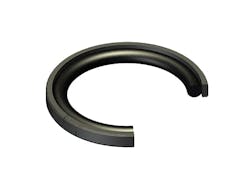Series 714 double-acting piston seals feature reinforced, heat-stabilized, thermoplastic sealing faces, equipped with a step-cut joint to allow easy passage over ports. A concentrated, tangent contact patch lies beneath the sealing face for dynamic sealing ability. The series is designed to prevent piston-to-bore contact in high-pressure applications with large extrusion gaps, and are well-suited for double-acting telescopic cylinders. The profiled nitrile-rubber energizer material can also be changed for different media and temperatures.
Hallite Seals Americas Inc., (248) 668-5200
About the Author
Leah Scully
Associate Content Producer
Leah Scully is a graduate of The College of New Jersey. She has a BS degree in Biomedical Engineering with a mechanical specialization. Leah is responsible for Hydraulics & Pneumatics’ news items and product galleries.

Leaders relevant to this article:

